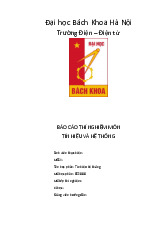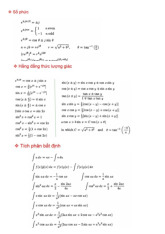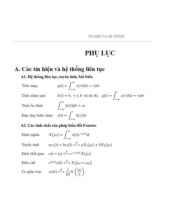















Preview text:
ELEG 3124 Assignment # 14 EE 2000 Assignment # 14
(taken from Dr. Jingxian Wu, University of Arkansas, 2020.)
1. Find the Convolution Sum between x(n) and h(n). (a) x(n) = 1n u(n), h(n) = u( 3 −n).
(b) x(n) = [1, 2, 3], h(n) = [1, 2] ↑ ↑
2. Find the Bilateral Z-transform of the following signals (a) x(n) = 3nu(−n − 2) (b) x(n) = [2, 1, 3, 5, 6] ↑
3. Consider a system described by the following difference equation
y(n) − 0.5y(n − 2) = 2x(n) − x(n − 1) − 0.5x(n − 2) (1)
(a) Find the transfer function in the Z-domain (b) Is the system BIBO-stable? 1 ELEG 3124 Assignment # 13 EE 2000 Assignment # 13
(taken from Dr. Jingxian Wu, University of Arkansas, 2020.)
1. Find the inverse Laplace transform (a) s+2 s2 −s−2 (b) 2 s s2 +3s+2 (c) s . s2 +2s+7 (d) 1 (s+2)2
2. Consider a system with input x(t) and output y(t) described in the
following equations. Find the impulse response h(t). x(t) = exp(−2t)u(t) (1)
y(t) = [exp(−t) − 3 exp(−2t)]u(t) (2)
3. Consider an LTI system described by the following equation (the system is initially relaxed)
y′′(t) + 4y′(t) + 3y(t) = 2x(t) − 3x′(t) (3)
(a) Find the transfer function H(s)
(b) Draw the first canonical form representation of the system (c) Is the system BIBO stable?
4. The block diagram of a system is represented in the figure shown in
the next page. Find the transfer function of the system. Is the system BIBO stable? 1 x(t) y(t) 1 + s−3 s+2 s+5 − s+1 s−2 2 ELEG 3124 Assignment # 12 EE 2000 Assignment # 12
(taken from Dr. Jingxian Wu, University of Arkansas, 2020.)
1. The Laplace transoform of a causal signal x(t) is s + 5 X(s) = , Re(s) > s2 + 3s + 2 −1 (1)
Using the properties of Laplace transform, find the Laplace transform of the following signals (a) 3x(t/3) (b) x(t − 2) (c) (t − 1)x(t). (d) dx(t) . dt (e) x(t) exp(−2t). (f) x(t) cos(2t) (don’t need to simplify)
2. Determine the initial value and final value of the signal whose Laplace transform is X(s) = s+2 . s2−2s−3
3. Solve the following differential equation:
y00(t) + 4y0(t) + 3y(t) = exp(−2t)u(t), y(0−) = 0, y0(0−) = 1 (2) 1 ELEG 3124 Assignment # 11 EE 2000 Assignment # 11
(taken from Dr. Jingxian Wu, University of Arkansas, 2020.)
1. Find the bilateral Laplace transform of the following signals. (a) exp(t + 1) (b) |t|. (c) exp(−2|t|). (d) cos(at)u(−t).
2. Find the unilateral Laplace transform of the following signals. (a) x(t) = t · rect t 1 − 2 (b) x(t) = Au(t) + 2δ(t). (c) x(t) = A cos(ω t 0 + θ). (d) x(t) = A sin(ω t 0 + θ). 1 ELEG 3124 Assignment # 10 EE 2000 Assignment # 10
(taken from Dr. Jingxian Wu, University of Arkansas, 2020.)
1. Consider a system with transfer function H(ω) = rect ω . The 2ωf
input signal is x(t) = sin(ω1t) + sin(ω2t) , where 0 < ω t t 1 < ω2.
(a) Find the impuse response h(t). (b) Find X(ω).
(c) Find y(t) is 0 < ωf < ω1.
(d) Find y(t) is ω1 < ωf < ω2.
(e) Find y(t) is ω2 < ωf .
2. The Fourier transform of x(t) is X(ω). The pulse train is p(t) = P∞ δ(t − nT n= s).
Define xs(t) = x(t)p(t) as the sampled signal of −∞
x(t) with a sampling period of Ts.
(a) Find the Fourier transform of xs(t).
(b) Assume the highest frequency of x(t) is ω0 and it satisfies 2ω0 ≤ ωs = 2π . Pass x T
s(t) through a low pass filter with transfer function s H(ω) = rect ω
, what is the time domain signal at the output ωs of the filter?
3. The amplitude modulation can be represented as s(t) = m(t) cos(ωct),
where m(t) is the message signal with the highest frequency ω0 and
cos(ωct) is the carrier signal. The carrier frequency is ωc and ωc >> ω0.
The Fourier transform of m(t) is M(ω).
(a) Find the Fourier transform of s(t).
(b) At the receiver, the coherent demodulator will perform r(t) =
s(t) cos(ωct), then pass the signal through a low pass filter with transfer function H(ω) = rect ω . Find the Fourier transform 2ω0
of r(t). Find the output of the low pass filter. 1 ELEG 3124 Assignment # 9 EE 2000 Assignment # 9
(taken from Dr. Jingxian Wu, University of Arkansas, 2020.) 1. Let X(ω) = 1
. Find the Fourier transform of the following functions 2+jω
by using the properties of the Fourier transform (a) tx(t) (b) x t2 − 1 (c) tdx(t) dt (d) (t − 1)x(t + 1) (e) x(2t − 1) exp(−j2t) (f) x(t) cos(ω0t)
2. Use the properties of Fourier transform, find the Fourier transform of the following signals. (a) sinc(t) (b) exp(jω0t) (c) sin(ω0t)
3. The impulse response of an LTI system is exp(−t)u(t). If the input is
exp(−2t)u(t), find the output of the system by using Fourier transform.
4. Using Parseval’s theorem, find the energy of the signal sinc(t). 1 ELEG 3124 Assignment # 8 EE 2000 Assignment # 8
(taken from Dr. Jingxian Wu, University of Arkansas, 2020.)
1. Find the Fourier transform of the following signals (a) s(t) = rect t−1 . 2 (b) s(t) = e−2tu(t) (c) s(t) = e2tu( t − )
(d) s(t) = 2e−3|t| + 2δ(t − 3)
2. Let X(ω) = rect ω−1 . Find the Fourier transform of the following 2
functions by using the properties of the Fourier transform (a) x( t − ) (b) x(−3t + 6) (c) dx(t) dt 1 ELEG 3124 Assignment # 7 EE 2000 Assignment # 7
(taken from Dr. Jingxian Wu, University of Arkansas, 2020.)
1. Find the periods and Fourier series coefficents of the following signals (a) s(t) = P∞ δ(t n=−∞ − n). (b) s(t) = P∞ ( n=−∞ −1)nδ(t − n)
2. A voltage x(t) is applied to the circuit shown in Fig. 2. If the Fourier
coefficients of x(t) are given by 1 cn = ejn π3 (1) n2 + 1
(a) Express the system in the form of a differential equation
(b) Find the transfer function of the system
(c) Plot the amplitude and phase of the transfer function with Matlab
(d) Find the first three non-zero harmonics of y(t)
Figure 1: Questions 2, 3, and 4.
3. Repeat Question 3 if y(t) is the voltage across the resistor instead.
4. For the RC circuit shown in Figure 2, find the voltage y(t) across the capacitor if the input is π x(t) = 1 + 3 cos t + + cos(2t) (2) 6 1 ELEG 3124 Assignment # 6 EE 2000 Assignment # 6
(taken from Dr. Jingxian Wu, University of Arkansas, 2020.) 1. For the periodic signal 1 π π x(t) = 2 + cos t + + 2 cos(3t) 5t + (1) 3 6 − 2 sin 6 (a) Find the Fourier series
(b) Use Matlab to sketch the magnitude and phase spectra as a func-
tion of the angular frequency Ω.
2. Find the Fourier series representation of the signals shown in Fig. 1.
Plot the magnitude and phase spectrum for each case. (a) (b) (c) Figure 1: Question 2
3. The signal shown in Figure 2 (next page) is created with a sine volt-
age is rectified by a circuit with two diodes, a process known as full-
wave rectification. Find the Fourier series of the signal. (Hint: x(t) =
sin(t), 0 < t < π. x(t) can be expressed as complex exponentials with Euler’s formula). 1 Figure 2: Question 3 2 ELEG 3124 Assignment # 5 EE 2000 Assignment # 5
(taken from Dr. Jingxian Wu, University of Arkansas, 2020.) 1, −1 ≤ t ≤ 1
Define a rectangular pulse p(t) = u(t+1)−u(t−1) = . 0, otherwise
1. An LTI system has an impulse response h(t) = tu(t − 5). If the input
is x(t) = t2[u(t − 1) − u(t − 3)], find the output.
2. Determine whether the contintuous-time LTI systems characterized by
the following impulse responses are causal or non-causal, stable or non- stable. (a) h(t) = e4tu(−t) (b) h(t) = (−t)e−tu(−t) (c) h(t) = e−|2t| (d) h(t) = p(t/2). (e) h(t) = δ(t) + e−3tu(t)
3. Are the LTI systems with the following impulse responses invertible?
If invertible, find the inverse system. (a) h(t) = 3δ(t + 3)
(b) h(t) = δ(t − 3) + δ(t − 5).
4. Consider a circuit with a voltage source, v(t), a resistor with resistance
R, and a capacitor with capacitance C connected in serise. If the input
of the system is the voltage source v(t), and the output of the system
is the voltage across the capacitor, vc(t). Write the system equation in
the form of a differential equation. 1 ELEG 3124 Assignment # 4 EE 2000 Assignment # 4
(taken from Dr. Jingxian Wu, University of Arkansas, 2020.) 1, −1 ≤ t ≤ 1
Define a rectangular pulse p(t) = u(t+1)−u(t−1) = . 0, otherwise
1. Evaluate the following convolutions (a > 0, b > 0). (a) u(t) ⊗ u(t) (b) p t a − ⊗ δ(t − b) a (c) p t ⊗ p t a a (d) p t ⊗ u(t). a (e) tu(t) ⊗ p t a
2. An LTI system has an impulse response as h(t) = exp(−2t)u(t). If the
input is x(t) = exp(−t)u(t) + u(t), find the output of the system.
3. Graphically evaluate the convolution: p(t) ⊗ p(t). 1 ELEG 3124 Assignment # 3 EE 2000 Assignment # 3
(taken from Dr. Jingxian Wu, University of Arkansas, 2020.)
1. Determine whether the following systems are linear or non-linear, causal
or non-causal, time invariant or time variant, and memoryless or with memory (a) y(t) = 2x(t) + 3 (b) y(t) = 2x2(t) + 3 (c) y(t) = Atx(t)
(d) y(t) = x(t)u(t) − x(t)u(−t) R (e) y(t) = t x(τ )dτ −∞ R (f) y(t) = t x(τ )dτ 0 (g) y(t) = x(t)x(t − 2) R (h) y(t) = 1 t+T /2 x(τ)dτ T t−T /2 1 ELEG 3124 Assignment # 2 EE 2000 Assignment # 2
(taken from Dr. Jingxian Wu, University of Arkansas, 2020.) 1. Let 2t + 2, −1 ≤ t < 0 x(t) = 2t − 2, 0 ≤ t < 1 (a) sketch x(t)
(b) sketch x(t − 2), x(t + 3), x(−3t − 2) and x 2t + 1 and find the 3 2
analytical expressions for these functions. 1/2, −1 < t < 1
2. The rectangular signal x(t) = p2(t) = is trans- 0, o.w.
mitted through the atmosphere and is reflected by different objects
located at different distances. The received signal is T y(t) = x(t) + 0.5x(t − ) + 0.25x(t − T ), T ≫ 2 (1) 2 Sketch y(t) for T = 10.
3. Sketch the following signals
(a) x1(t) = u(t) + 5u(t − 1) − 2u(t − 2)
(b) x2(t) = r(t) − r(t − 1) − u(t − 2) (c) x3(t) = x1(2t + 4)
4. Evaluate the following integrals: (a) R ∞ 2 t − 3 δ(t − 1)dt −∞ 3 2
(b) R ∞ (t − 1)δ 2t − 3 dt −∞ 3 2
(c) R 2 [exp(−t + 1) + sin(2πt/3)]δ(t − 3/2)dt −3
(d) R −2[exp(−t + 1) + sin(2πt/3)]δ(t − 3/2)dt −3 1 ELEG 3124 Assignment # 1 EE 2000 Assignment # 1
(taken from Dr. Jingxian Wu, University of Arkansas, 2020.)
1. Perform even and odd decomposition of the following signals. (a) s(t) = eΩ0t sin(2t + 3), t > 0, (b) s(t) = 0, otherwise.
2. Are the following signals periodic? If so, find their periods.
(a) x(t) = sin(πt/3) + 2 cos(8πt/3)
(b) x(t) = exp j 7π t + exp 5π t 6 6
(c) x(t) = 2 sin 3π t + cos 3 t 8 4
3. Determine whether the following signals are power or energy signals or neither. Justify your answers.
(a) x(t) = A sin(t), −∞ < t < ∞
(b) x(t) = exp[−at], a > 0, t > 0 (c) x(t) = A exp[bt], b > 0
(d) x(t) = exp[−(a + jb)t], a > 0, t > 0 1




